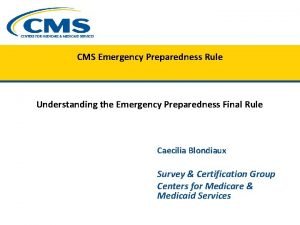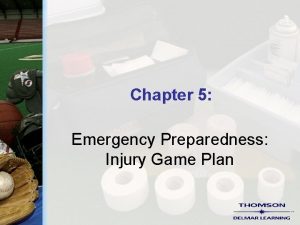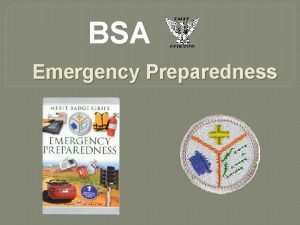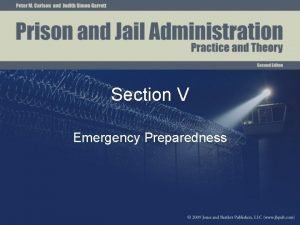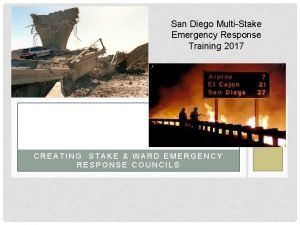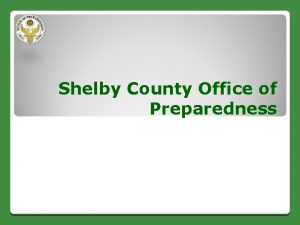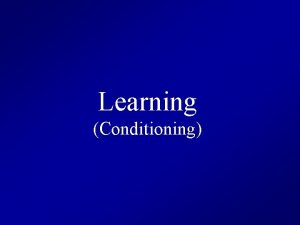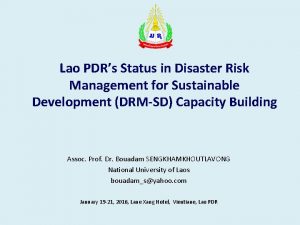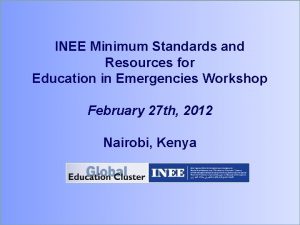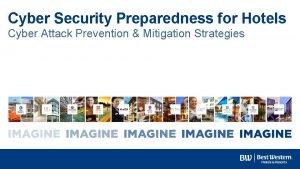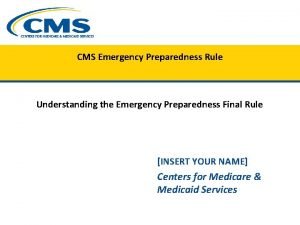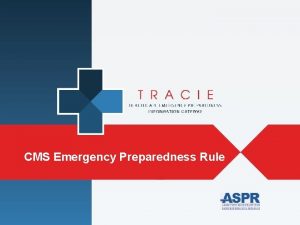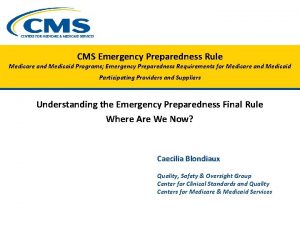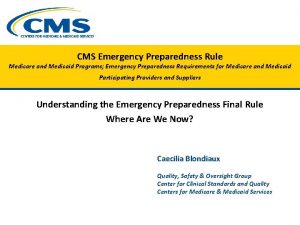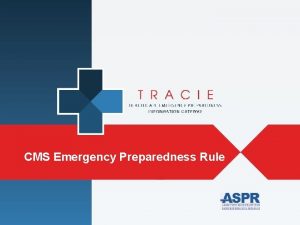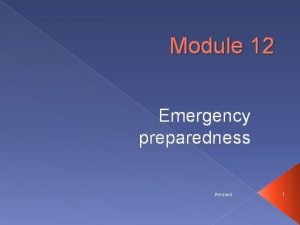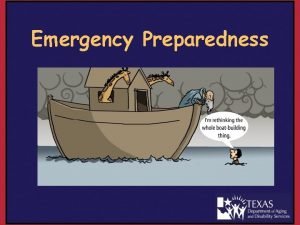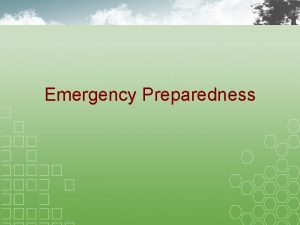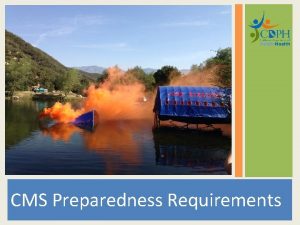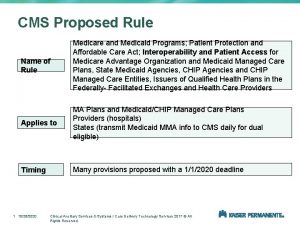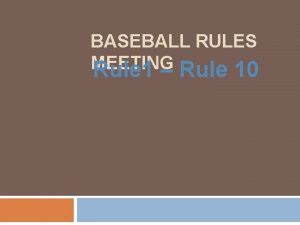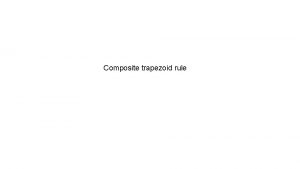CMS Emergency Preparedness Rule Understanding the Emergency Preparedness
















- Slides: 16

CMS Emergency Preparedness Rule Understanding the Emergency Preparedness Final Rule Survey & Certification Group Centers for Medicare & Medicaid Services

Final Rule • Medicare and Medicaid Programs; Emergency Preparedness Requirements for Medicare and Medicaid Participating Providers and Suppliers • Published September 16, 2016 • Applies to all 17 provider and supplier types • Implementation date November 15, 2017 • Compliance required for participation in Medicare • Emergency Preparedness is one new Co. P/Cf. C of many already required 2

Four Provisions for All Provider Types Risk Assessment and Planning Policies and Procedures Emergency Preparedness Program Communication Plan Training and Testing 8

Risk Assessment and Planning • Develop an emergency plan based on a risk assessment. • Perform risk assessment using an “all-hazards” approach, focusing on capacities and capabilities. • Update emergency plan at least annually. 9

Policies and Procedures • Develop and implement policies and procedures based on the emergency plan and risk assessment. • Policies and procedures must address a range of issues including subsistence needs, evacuation plans, procedures for sheltering in place, tracking patients and staff during an emergency. • Review and update policies and procedures at least annually. 10

Communication Plan • Develop a communication plan that complies with both Federal and State laws. • Coordinate patient care within the facility, across health care providers, and with state and local public health departments and emergency management systems. • Review and update plan annually. 11

Training and Testing Program • Develop and maintain training and testing programs, including initial training in policies and procedures. • Demonstrate knowledge of emergency procedures and provide training at least annually. • Conduct drills and exercises to test the emergency plan. 12

Requirements Vary by Provider Type • Outpatient providers are not required to have policies and procedures for the provision of subsistence needs. • Home health agencies and hospices required to inform officials of patients in need of evacuation. • Long-term care and psychiatric residential treatment facilities must share information from the emergency plan with residents and family members or representatives. 14

Interpretive Guidelines (IGs) “The IGs are sub regulatory guidelines which establish our expectations for the function states perform in enforcing the regulatory requirements. Facilities do not require the IGs in order to implement the regulatory requirements. We note that CMS historically releases IGs for new regulations after the final rule has been published. This EP rule is accompanied by extensive resources that providers and suppliers can use to establish their emergency preparedness programs. ” Federal Register /Vol. 81, No. 180 / Friday, September 16, 2016 /Rules and Regulations 63873

Compliance • Facilities are expected to be in compliance with the requirements by 11/15/2017. • In the event facilities are non-compliant, the same general enforcement procedures will occur as is currently in place for any other conditions or requirements cited for non-compliance. 18

The SCG Website • Providers and Suppliers should refer to the resources on the CMS website for assistance in developing emergency preparedness plans. • The website also provides important links to additional resources and organizations who can assist. • https: //www. cms. gov/Medicare/Provider-Enrollment -and. Certification/Survey. Cert. Emerg. Prep/index. html 19

The SCG Website- Continued • Left Links on the website provide a variety of resources available

The SCG Website- Continued

FAQs • Frequently Asked Questions (FAQs) have been developed and are posted on the CMS Emergency Preparedness Website https: //www. cms. gov/Medicare/Provider-Enrollmentand-Certification/Survey. Cert. Emerg. Prep/Emergency. Prep-Rule. html • We will continue to edit and post new FAQs as inquiries are received.

Training Considerations Don’t Lose Sight of the Intent! • Providers/Suppliers and Emergency Preparedness officials should consider aiming training on overall Emergency Preparedness, with integration of the four core elements. • Work toward assisting emergency preparedness officials and facility leadership on “how-to” guides – i. e. how do you complete a hazard vulnerability assessment/ risk assessment? How do you draft a communication plan?

Thank you! SCGEmergency. Prep@cms. hhs. gov
 Cms emergency preparedness final rule
Cms emergency preparedness final rule Chapter 5 emergency preparedness injury game plan
Chapter 5 emergency preparedness injury game plan Chapter 36 emergency preparedness and protective practices
Chapter 36 emergency preparedness and protective practices Bsa emergency preparedness
Bsa emergency preparedness National radiological emergency preparedness conference
National radiological emergency preparedness conference Chapter 36 emergency preparedness and protective practices
Chapter 36 emergency preparedness and protective practices Stake emergency preparedness plan
Stake emergency preparedness plan Learning that remains hidden until it is needed
Learning that remains hidden until it is needed Shelby county office of preparedness
Shelby county office of preparedness Biological preparedness
Biological preparedness Conditioning learning
Conditioning learning Conclusion disaster management
Conclusion disaster management Preparedness mitigation response recovery
Preparedness mitigation response recovery Biological preparedness
Biological preparedness Promoting family earthquake preparedness
Promoting family earthquake preparedness Data breach preparedness
Data breach preparedness 1achors
1achors
